Best Places to Visit in Spiti Valley
Spiti, hidden away in a warm embrace of natural splendor, is a wonderful entrance for those seeking seclusion amid the serenity of nature. Tourism in Lahaul Spiti draws thousands of visitors each year because of its captivating beauty and natural surroundings. Best Places to Visit in Spiti: Ladakh, Tibet, Kinnaur, and Kullu Valley are Spiti’s northern neighbors. Kinnaur is Spiti’s southern neighbor.
Himachal Pradesh’s spectacular cold desert valley is filled with pine trees, lush meadows, stunning monasteries, and populated villages that will leave you completely speechless. The desolate mountains out here, which are located at an elevation of roughly 12,500 feet above sea level, change color constantly and are a sight to behold.
The population of the tiny communities here, which are surrounded by enormous mountains, ranges from 35 to 200. This sparsely populated area is a piece of paradise for anyone who longs to escape the enticing city life.
Anywhere you go, you’ll see stunning Buddhist monasteries, prayer flags flying in the air, and a lot of monks around their prayer wheels in a mass prayer. Here, you may also get an amazing view of Chandratal Lake and Dhadkan. With their incredible altitude, passes like Kunzum and Barchala Pass will further transport you to the top of the globe.
Visitors have the option of taking a nature trail nearby to see uncommon avian species and breathtaking natural splendor. Adventure sports including hiking, rappelling, and camping are available here. Step outside the boundaries of your routine existence and board the Spiti Wonderland to enjoy some nature-inspired photography.
Because Spiti is a frigid desert valley, it always has extremely low temperatures. However, summer is undoubtedly more enjoyable than the other seasons because it progressively warms up to 0 to 15 degrees Celsius.
People avoid traveling to this wonderland during the incredibly chilly winters in Spiti. People avoid traveling to Spiti during the monsoon because of the regular severe rain and landslides that occur during this time.
Book Here Spiti Valley Tour Packages.
Important Information Before Visiting Spiti Valley
- Avoid self-drive at all costs; it can be rather dangerous to travel from Manali to Kaza. It is advised that you use a bus to go where you are going.
- In Kaza, there are just one or two ATMs, and they could run out of cash. Therefore, be sure you have enough cash on hand.
- Previously a well-liked camping location, camping is now prohibited within three km of Chandratal Lake.
- Normal operating months for the Kunzum Pass are June through September. It is frozen for the remainder of the year.
- Since there are no restaurants on the Kunzum Pass, it is advised to stock up on food before the trip.
- The permit must be in many copies because it might need to be shown at various checkpoints on the way to Sarchu.
- It should be mentioned that the campers in Sarchu will be closed during the winter months due to the significant amounts of snowfall.
- It is strictly forbidden to take photos inside such temples and monasteries.
Here are some Best Places to Visit in Spiti Valley
1. Chandratal Lake
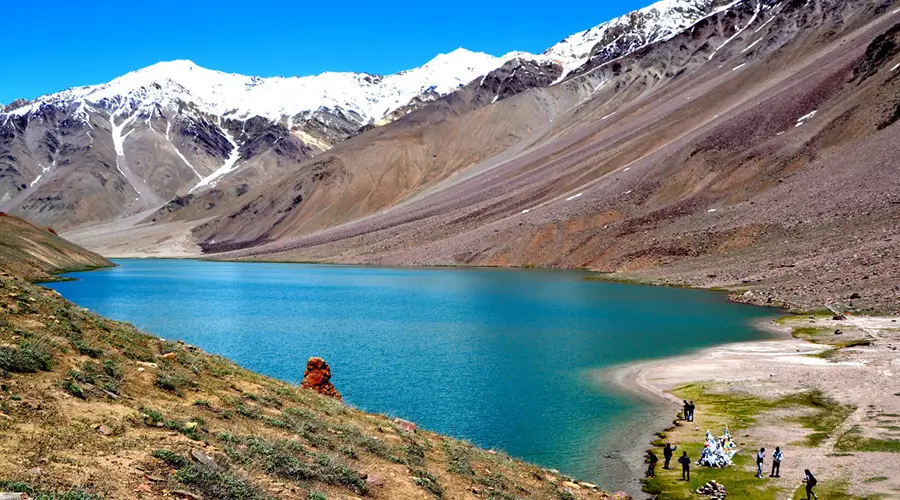
Overview of Chandratal Lake and Best place to visit Spiti Valley
One of the most stunning lakes, Chandratal Lake, is situated in the great Himalayas at a height of roughly 4300 meters. The lake is the source of the Chandra River and is located on the Samudra Tapu plateau in the Lahaul region of the Lahaul and Spiti district.
The crescent-shaped lake earned the name “Chandra Taal” (Lake of the Moon). Additionally, this lake is one of the two high-altitude wetlands in India that have received the Ramsar designation. It now draws tens of thousands of adventure seekers after serving as a temporary dwelling for Tibetan traders visiting Spiti and the Kullu region. As the day draws to a close, the hue of the water in this sacred lake keeps shifting from reddish to orange to blue to emerald green. The nicest camping spots may be found among vast lengths of green meadows, which are also home to a variety of wildflowers in the spring.
According to legend, Yudhishthira, the eldest of the Pandava brothers, was brought up by God Indra’s chariot from a location near the Chandratal Lake. Due to this feature, a large number of Hindu devotees go to the lake, making it sacred. Although the journey from Batal to Chandratal can be arduous, the breathtaking scenery and charm of the region make it worthwhile. Chandratal Lake appears to be crystal clear as the sun’s light reflects off its surface.
Things You Should Know Before Visiting Chandratal Lake
Note:
Previously a well-liked camping location, camping is now prohibited within three km of Chandratal Lake.
It is recommended to avoid embarking on a trek during the monsoon because the extremely high water levels in the rivers and lakes may hamper your movement.
How To Reach Chandratal Lake
From Delhi, there are two practical ways to get to Chandratal Lake. The alternate path travels to Spiti Valley while the first route passes through Manali and Shimla.
Routes starting from Shimla
Starting in Delhi, this route goes to Narkanda. One can travel to Kalpa from here and then on to Kaza and Nako. After stopping in <strong>best places to visit Spiti Valley, move from Kaza in the direction of Chandratal Lake. It is advised to travel along this route from Shimla to Kinnaur before continuing to Spiti Valley. Chandratal Lake is accessible after leaving Spiti Valley.
Manali travel routes:
The Manali route is your best option if you want to take a quicker route to Chandratal Lake. You will begin your adventure in Delhi, travel through Mandi, Kullu, Rohtang La, Battal, and Gramphoo, and then arrive at Chandratal Lake.
Using public transport:
There are two ways to Chandratal that you can choose from if you’re taking public transit.
Manali to Chandratal: In the early morning, two buses go between Manali and Kaza. At 4:30 AM, the bus departs from Kullu and transports you to Manali. The cost of a ticket to Kaza from here is only about Rs 250 per person. You can walk to Chandratal Lake after arriving at Chandratal diversion point by dusk.
-Shimla to Chandratal: Two non-air-conditioned buses connect Shimla with Reckong Peo. A 7:00 AM HRTC bus will take you from Reckong Peo to Kaza. Take a bus to Manali from Kaza, then get out at the Chandratal Lake detour. You can walk the remaining distance from this point onward.
Road Situation:
The road conditions worsen as you leave the Manali-Leh highway. The route from Gramphu to Batal is merely a rough, unpaved road that crosses multiple bodies of water. Even if you chose the Kaza-Chandratal route, the state of the roads won’t significantly improve. Due to the existence of rocky formations, the entire path has numerous problematic areas.
Quick Facts about Chandratal Lake
Weather: -3 – 4°C
Label: Must Visit
Tags: Lake
Time Required: 2-3 hrs
Weather and Best Time to Visit: The best time to visit Chandratal is between July and August.
2. Key Monastery
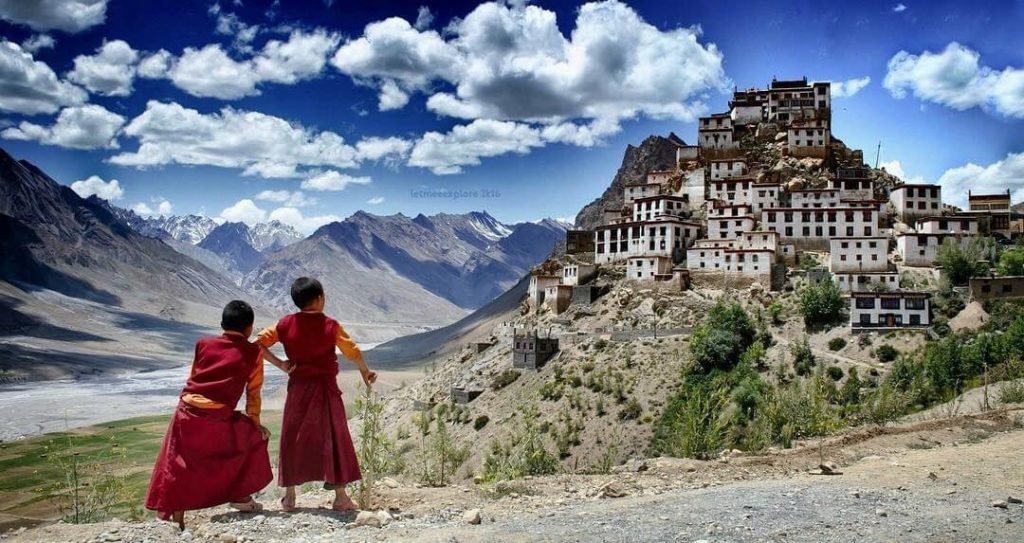
Overview of Key Monastery, Spiti Valley
In India’s Lahaul and Spiti District sits the well-known Tibetan Buddhist monastery known as The Key Monastery. The monastery in the Spiti Valley of Himachal Pradesh, India, is next to the Spiti River and is situated at an elevation of 4,166 meters above sea level. Additionally known as the Kye Monastery and Ki Monastery, it is thought to have been established in the 11th century by Dromton, a pupil of the illustrious teacher Atisha. There are murals and a collection of old literature in addition to idols of Buddha that are placed in the Dhyana pose.
The magnificent Key Monastery is the greatest in the entire Spiti Valley and is over a thousand years old. Around 300 Lamas acquire their religious education from the majestic monastery, which also serves as a center for their religious training. It has a lengthy and fascinating history, one that is filled with countless assaults that the location has endured. Despite this, Kye Monastery endured, and in 2000, the Dalai Lama attended a celebration to mark the monastery’s completion of a millennium.
Notes Before Visiting Key Monastery
1. Avoid self-drive at all costs; it might be fairly unsafe to travel from Manali to Kaza. It is advised that you use a bus to go where you are going.
2. In Kaza, there are only one or two ATMs, and they could run out of cash. Therefore, be sure you have enough cash on hand.
3. The monastery offers lodging choices upon advance notification. This is a great chance to interact with the monks and experience their peaceful way of life. The cost per night, including meals, is INR 250.
4. The monastery’s monks are incredibly helpful and polite. So don’t be afraid to ask them questions to learn more about the area.
5. Be sure to sample the herbal tea offered here. It’s incredibly reviving and beneficial for the body’s circulation of oxygen.
How To Reach Key Monastery
The closest bus station to the Key Monastery is in Kaza, which is 14 km away. Whether you are traveling from Manali or Shimla, you must first arrive at Kaza to access the Key Monastery. Bus service from Manali and Shimla to Kaza is widespread, and it often takes 10 to 12 hours to get there.
You will then need to hire a private cab to drive you the last 40 minutes to the monastery. It’s a difficult and steep trek to the monastery.
Best Time To Visit Key Monastery
Except for the monsoon month of August, the optimum time to visit this lovely monastery is from the middle of June until the beginning of September. The Himalayas have considerable precipitation at this time of year, which causes landslides and slick roadways. Due to its high altitude, Key Monastery experiences cold weather most of the year; nonetheless, the summer months are lovely.
The Rohtang Pass, which opens in the second week of June and closes on the 15th of October due to severe snowfall, must be crossed if you intend to travel there from Manali. Additionally, because of the increased risk of landslides during the monsoon season, it is closed. If you want to take the other, year-round route via Shimla and Kaza, the best time to visit the old monastery is from June to October.
3. Kunzum Pass
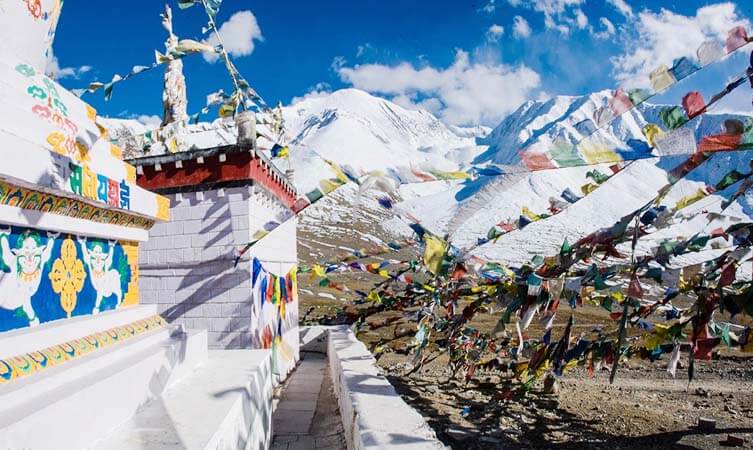
Overview of the Spiti Valley’s Kunzum Pass
At 4,551 meters above mean sea level, Kunzum Pass, or Kunzum La as it is known to locals, is one of the highest motorable mountain crossings in India. It acts as a point of entry to the stunning Spiti Valley from Kullu and Lahaul. It is located 122 km away from Manali in the eastern Kunzum Range of the Himalayas.
Astonishing panoramas of the Chandrabhaga Range, the Spiti Valley, and the second-longest glacier in the world, Bara-Shigri Glacier, are all available from Kunzum La. A photographer’s paradise, Kunzum Pass is known for its captivating perspective.
From Kunzum Pass, a 15-kilometer walk leads to the well-known Chandratal Lake (Moon Lake). On their journey to the pass, travelers are said to have to make a pit stop at the shrine of Goddess Kunzum Devi to pay their respects and ask for guidance on how to navigate the treacherous terrain safely. It is customary to drive around the temple once in its entirety.
How To Reach Kunzum Pass
– By Road: From Manali, one can get to Kunzum Pass by HRTC buses or by hiring private taxis. It takes 6-7 hours to travel from Manali to Kunzum Pass.
– By Air: Bhuntar town is home to the area’s closest airport to Kunzum Pass. Kunzum Pass is 170 km away from Bhuntar Town, while Manali is 50 kilometers away. From the airport, one can go to Manali by vehicle or bus or by using the pass.
– By Train: The 50 km away narrow gauge Joginder Nagar railway station is the closest rail hub to Kunzum Pass. Taxis are available for hire from there to Kunzum Pass.
Best Time To Visit Kunzum Pass
The second week of June through September, except August, is the best season to visit the Kunzum route because the route is closed in the monsoon and winter. The Kunzum Pass stays temporarily blocked due to significant snowfall during the winter months, from October 15 until April.
Despite being open during the monsoon month of August, visitors shouldn’t schedule a trip because of the slick roads and potential for landslides.
Things to Know Before Visiting Kunzum Pass
1. If taking a bus, double-check that it will be running the day before. Additionally, arrive early at the station to secure a decent seat because reservations are not allowed.
2. It is preferable to get an SUV if you are hiring a private taxi.
3. Altitude sickness might strike. Take the necessary safety measures.
4. On the approach to the Pass, be sure to take in the breathtaking vista of the Bara-Shigri glacier.
5. Because there are no restaurants in the Pass, it is advised to stock up on food before setting off.
Quick Facts about Kunzum Pass
Weather: -3 – 4°C
Label: Must Visit
Tags: Hills & Valleys
Timings: Sunset to Sunrise
Time Required: 2-3 hrs
Entry Fee: No entry fee
4. Tabo Monastery
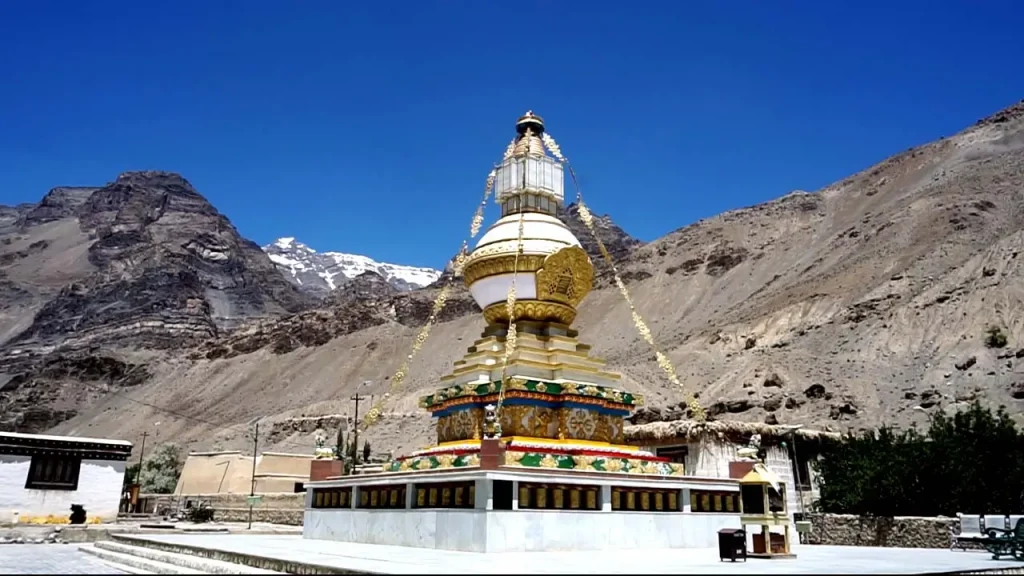
Overview of Tabo Monastery in the Spiti Valley
One of the oldest monasteries is the Tabo Monastery, which is situated in the Tabo Village of the Best Places to Visit in Spiti Valley at a dizzying height of 10,000 feet. It is, in fact, the oldest monastery in both India and the Himalayas that has always been in operation. The ‘Ajanta of the Himalayas’ is a term used to describe this beautiful monastery.
The monastery’s walls are adorned with intriguing murals and historic paintings, giving rise to its name and similarity to the Ajanta Caves in Maharashtra. The Tabo Monastery, which is proud to have retained the beautiful traditions and heritage of Buddhism in the form of artistic murals, detailed paintings, gorgeous stuccos, and exquisite frescoes, is situated serenely on the left bank of the dazzling Spiti River.
The Archaeological Survey of India has assumed control of maintaining and preserving one of the most historically significant places in the Buddhist civilization. This culturally rich heritage monument, which covers an area of 6300 square kilometers in the chilly desert of the Tabo Valley and is encircled by thick walls made of mud bricks, is widely venerated by Buddhist monks and is second only to the Tholing Gompa in Tibet in terms of importance. The Tabo Monastery, which was built by the renowned Buddhist king Yeshe-O, is today a treasured treasure in the Buddhist world.
How To Reach Tabo Monastery
From Tabo Monastery, there is no direct train or flight connection. To get to the Tabo Monastery, one must divide their journey into many stages.
1. Taking a Bus: The closest significant bus station with interstate buses is Reckong Peo bus stand. Reckong Peo and Tabo are separated by a 150 km distance. The Tabo Monastery can be reached by foot from there. You must arrive on time because there aren’t many buses, and the first one leaves at 6:30 in the morning.
2. Traveling independently from adjacent major cities: From Manali, it will take you around 5 hours to drive 250 km, while the drive from Shimla would take you 10 hours to complete 377 km.
3. Getting There by Train: The closest intercity train station is Dehradun (DDN). The closest local train station with a limited train selection is Shimla Railway Station (JDNX).
4. Coming by Flight: If you’re traveling by air, Chandigarh Airport (IXC) is the closest major airport. Bhuntar Airport (KUU), another nearby airport, offers few options for local flights.
Things to Know Before You Visit Tabo Monastery
1. To fully enjoy the monastery, a one-night stay at the guest house is advised.
2. Because it is always cold, it is necessary to carry strong wool clothing.
3. You must try the local Tabo cuisine. Butter tea with Tibetan bread is a delicacy served by the monks and is highly recommended.
4. Bring a torch with you when you visit the monastery because there is no electricity there. It is always advisable to ask a monk to go with you when you explore the monastery because they are quite knowledgeable about the local history.
5. You can purchase postcards, thangka paintings, and souvenirs in the local gift shops. The monastery is preserved using the money from all sales.
6. Between April and October, when the cold is bearable, is the ideal time to visit the Tabo Monastery.
7. It’s not allowed to take photos within the temples.
Best Time To Visit Tabo Monastery
Avoid visiting this old monastery during January through April as temperatures range from 2 degrees to 14 degrees Celsius during this time, and the majority of the roads are closed due to severe snowfall. Even the residents choose to stay inside their warm homes during this time and make themselves comfortable there.
The tourist season starts in May and lasts through October. However, August should be avoided during the monsoon season because it brings very heavy rains to the Spiti Valley rain shadow region and makes the Himalayan routes treacherous and prone to landslides.
Only the Best Places to Visit in Spiti Valley is open to tourists from May to October; from November on, a lot of snow falls. The ideal journey should last seven to eight days.
Quick Facts about Tabo Monastery
Weather: -3 – 4°C
Label: Must Visit
Tags: Buddhist Temple
Timings: 6:00 AM – 7:00 PM
Morning prayers: 6:00 AM
Classes for Monks: 8:00 AM to 9:00 AM (can be attended with prior permission.)
Entry Fee: No entry fee
Founder : Rinchen Zangpo
Opened: 996 AD
Style: 9 temples, 4 Stupas, 23 chortens, monks quarters
Sect : Gelug
5. Sarchu
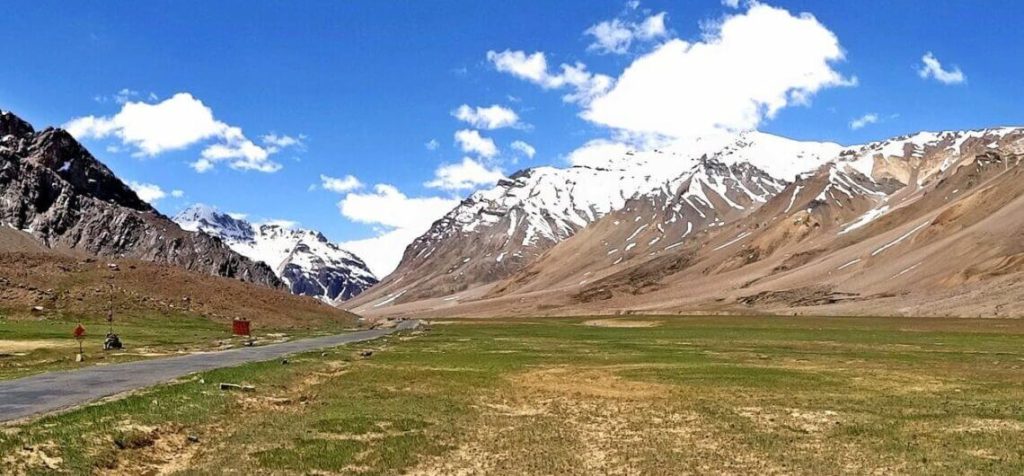
The Spiti Valley, Sarchu Overview
People who travel along the Leh-Manali Highway frequently choose to overnight in Sarchu, which is located on the border of Ladakh and Himachal Pradesh. It is 252 kilometres from Leh and 222 km from Manali.
At 4,290 meters above sea level, Sarchu is also known as Sir Bhum Chun. Between the Lachulung La and Baralacha La mountains in the north and south, it is located. It takes roughly two days to travel due to its high altitude and bad road sections. As a result, to unwind, travelers and tourists camp at Sarchu.
The Leh-Manali route passes by the camping area on the Himalayan mountain range, which provides a dual view of the surrounding landscape. Between May and October, a lot of semi-permanent campers are open from where one can slowly admire the natural beauties. Knowing that Sarchu was a significant Silk Road commerce hub is exciting. The nomadic tribes, traders, and adventurers continue to enjoy its popularity.
Best Time to Visit Sarchu
The months of May through September are the ideal for travel since they have a milder environment than the other months of the year. Due to the significant snowfall throughout the winter, the majority of campgrounds are also closed. As a result, this is the best time to visit the location in comfort.
Quick Facts about Sarchu
Weather : -3 – 4°C
Tags : Hills & Valleys
Timings : 24 hours
Entry Fee : No entry fee
6. Dhankar Monastery
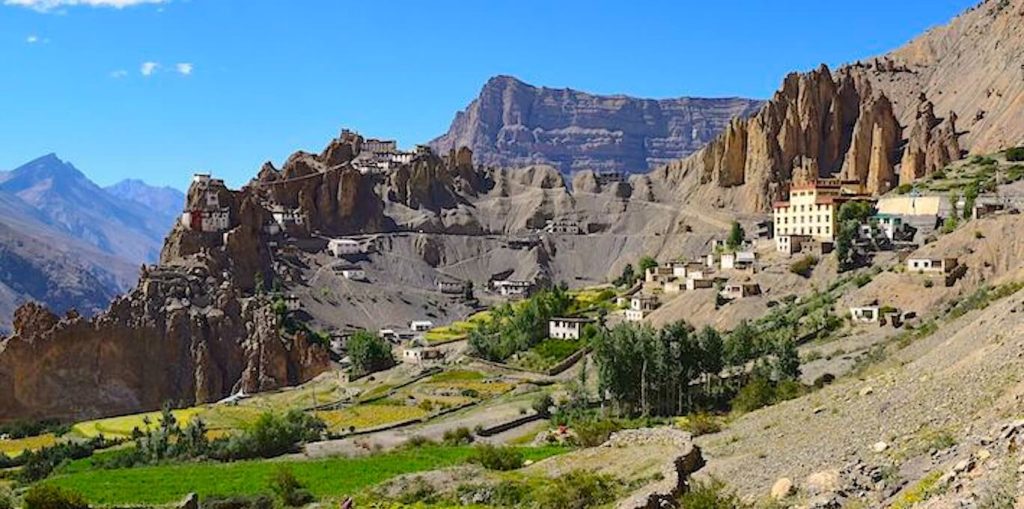
Overview of Dhankar Monastery in the Spiti Valley
Dhankar Monastery, also known as Dankhar, Drangkhar, or Dhangkar Gompa, is located in the Himachal Pradesh district of Lahaul and Spiti. The monastery gives a panoramic view of the Best Places to Visit in Spiti Valley and is located precariously on the edge of a cliff at an elevation of 12,774 feet. Dhankar Monastery, one of the world’s 100 most endangered monuments, was constructed a thousand years ago on a mountain that rises 1,000 feet above sea level and offers breathtaking views of the confluence of the Spiti and Pin rivers.
The monastery has gained popularity as a popular tourist attraction since it is one of the major centers of Buddhist art and culture. The Dhankar Hompa features beautiful views in addition to the statue of Dhayan Buddha and a tiny museum that houses sacred texts and artwork. In the village of Shichilling, which is located under the monastery, there is a new monastery that is home to about 150 Gelug school monks. The picturesque Dhankar lake is accessible by a 2 kilometer walk from the monastery.
How To Reach Dhankar Monastery
Either Shimla or Manali are good places to start your journey to Dhankar Monastery. The quickest way is through Manali, but alas it is not open all year. Shimla is therefore always the suggested route. Although there are only roads leading to the monastery, there may be some assistance from airlines and trains from your starting point to Shimla and Manali. Other than driving alone, you can choose from the following choices from either of the two locations:
– By Taxi: Dhankar Monastery is only 34 kilometers from Kaza, which you may reach by taking a cab from Manali. To get to the Dhankar Monastery if you are starting your journey from Shimla, you must take a taxi to Kaza and then descend between Tabo and Kaza at Dhankar.
– By Bus: You can take a bus from Manali to Kaza, where you can take a taxi to get to the monastery, by the evening of the day you left. From Shimla to Reckong Peo and then from Reckong Peo to Kaza, you can travel by bus. To go to the Dhankar Monastery, you must remember to drop out somewhere between Tabo and Kaza.
– By car: You can easily drive your own vehicle to the monastery while taking in the scenic surroundings of the routes. You can go across the Rohtang Pass via Manali to get to Kaza. The travel to the monastery would take less than an hour from there. If utilizing a personal vehicle, just be sure to have a permit to drive on the Rohtang Pass.
The drive from Shimla, though, is both simple and exciting. As you go from Shimla to Kaza, you should stop at Dhankar, where you will find the Dhankar Monastery, just before Tabo and before Kaza.
Best Time To Visit Dhankar Monastery
Due to the excellent weather in Dhankar, visitors plan trips there all year round. However, the region experiences extremely chilly winters, thus it is advised against visiting during those chilly months. The months of May through September are the finest for travel to this location. The summertime temperature fluctuates from 5 to 20 degrees Celsius, and the weather is generally cool.
Essential Information
The village is situated between the towns of Kaza and Tabo, which is important information.
– Dhankar monastery is perched at a height of 3,894 meters.
– The monastic complex is accessible every day of the week.
– The establishment is open from 6:30 am till 5 pm.
– It is regarded as one of the top 100 endangered architectural structures in the world.
– If you take a cab, it will take you an hour to go the 39.3 km between Dhankar Monastery and Spiti.
– The estimated driving time from Manali to Dhankar Monastery is 5 and a half hours. The distance between the two locations is 235.6 kilometers.
Tips for Visiting Dhankar Monastery
– Be sure to schedule your visit to the monastery during the summer.
– Have plenty of time to saunter about the monastery’s grounds.
Spend a few days in the monastery, if you can.
– Savour the Tibetan cuisine that is provided in the monastery.
– Walk the 2 KM distance to Dhankar Lake from the monastery.
7. Pin Valley National Park
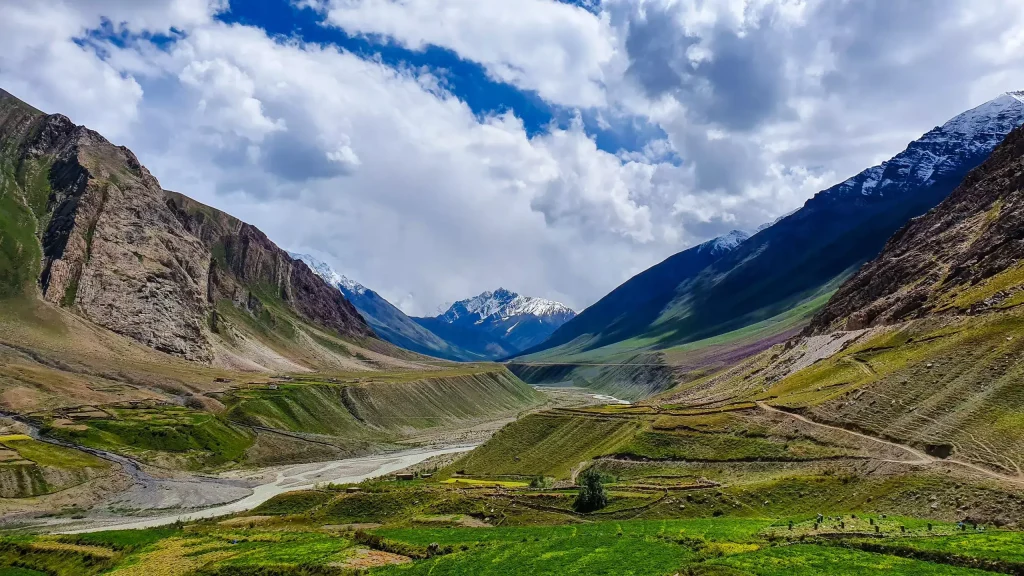
Overview of the Spiti Valley’s Pin Valley National Park
The Pin Valley National Park is located in the Cold Desert Biosphere Reserve, which is part of Himachal Pradesh’s Lahaul and Spiti District, and is surrounded by partially frozen rivers in the Pin Valley. The elevation of the park varies from roughly 3,500 metres at Ka Dogri to more than 6,000 metres at its highest point.
The Pin Valley National Park is one of the most fascinating places of its sort and is home to the endangered Himalayan snow leopards and their prey, the ibex. The National Park is most well-known for its amazing trek, which is enjoyed by all of its visitors. Since it snows for the majority of the year, the walk is an exciting and daring journey.
The Pin Valley park’s core zone spans a sizable 675 sq km area, while its buffer zone is over 1150 sq km. The endangered snow leopard, the most notable resident of Pin Valley Park, is one of the nearly 20 kinds of plants and animals that call it home today.
Additionally, this area is home to Siberian Ibex, Bharal, red fox, weasel, and marten. The area is also home to a number of bird species, including pikas, snow cocks, bearded vultures, chukors, golden eagles, griffons, Himalayan choughs, and ravens.
How To Reach Pin Valley National Park
Choose between the two following paths to go to the Pin Valley National Park:
Summer Route: Available from July to October: To travel the 272 km between Chandigarh and Shimla and Kullu, one can take the road or the air. You must take a bus across Rohtang Pass and Kunzum Pass, which is an additional 260 km, to get from Kullu to Kaza via Manali.
You will need to take a bus or jeep the 32 km from Kaza to Mikkim. The remaining 10 kilometers can be traveled on foot to get to the park starting from Mikkim.
Winter Route: Open during the remaining months:You must travel this route by traveling to Shimla and then traveling by bus to Tapri. Take a bus to Kaza from Tapri. The Pin Valley National Park, which is 32 kilometers above Kaza and 10 kilometers away, will be traveled on foot.
Shimla and Kullu are the locations of the closest train routes and air support, respectively. You will have access to a lot of local assistance at each of these locations to direct you.
Best Time To Visit Pin Valley National Park
From July to October: This is a really pleasant weather period. Since the weather is neutral throughout this time, August is one of the best months to travel.
From November through March, the region experiences heavy snowfall and very cold temperatures. The best time for people to visit this national park could not be at that moment.
From April to June, the area sees moderate sunshine and the end of the winter season, but there are still few tourists around. In this dry area, rain is quite infrequent.
8. Suraj Tal Lake
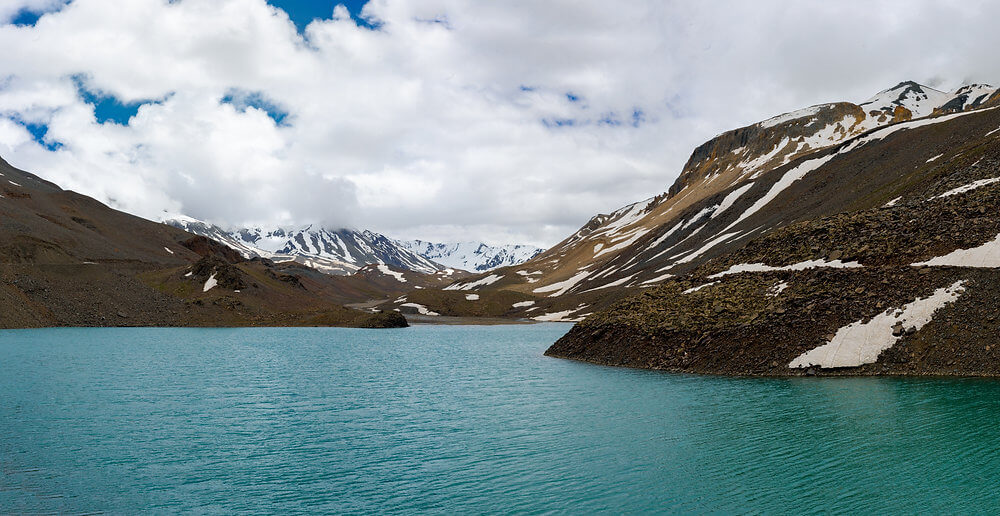
Overview of the Suraj Tal, Spiti Valley
Suraj Tal Lake, which is 4950 meters above sea level, is ranked as India’s third-largest lake. Suraj Tale is located in the Best Places to Visit in Spiti Valley. ‘The Lake of Sun God’ is what it literally means. The breathtaking lake located just below the Baralacha pass should unquestionably be seen while here, especially if one enjoys photography. One of the most picturesque and dreamy lakes is the Suraj Tal.
“The Suraj Tal lake draws a lot of people and is regarded as spiritual because it is thought that swimming in it cleanses one of their sins.”
However, the main factor in the lake’s rise to fame is its proximity to the well-known Manali-Leh trail, a popular route for bicycling and trekking excursions that also includes the Baralacha-La Pass. Suraj Tal is therefore intended for those who are both adventurous and devout.
How To Reach Suraj Tal
Suraj Tal doesn’t have train, bus, or air service, but it is well accessible by road, so you may get a cab from Keylong and travel here without any difficulty.
Via car: Suraj Tal is around 65 kilometers from Keylong via road. From National Highway NH 21, popularly known as the Leh-Manali highway, Keylong district is easily reachable by vehicle. For the people who live in Lahaul Spiti, this is the most important road connection. Bara-lacha la pass is only 3 kilometers away from the route that leads to Suraj Tal. Winter renders this picturesque path from Rohtang Pass to the Leh area completely impassable.
Best Time To Visit Suraj Tal
When the snow starts to melt and the weather in Suraj Tal warms up, the optimum time to visit is from mid-April to mid-May. This location is also accessible from mid-May to mid-July, when the summer season is in full swing and throngs of people flock there to take in its ethereal splendor.
Wintertime: Due to the hostile environment, you should avoid visiting Suraj Tal during the winter. Additionally, the routes that lead there are shut down. Furthermore, the water body is completely covered in snow and the temperature drops to -2 degrees Celsius.
When it’s monsoon: You should also avoid going to Suraj Tal from July to September because of the risky landslides and constant, torrential rain that occurs during this time. Due to the possibility of disasters, the majority of the entrance routes are also closed during the monsoon.
Tips for Visiting Suraj Tal
Here are some recommendations for visiting Suraj Tal:
1. For extended treks close to Suraj Tal, be sure to bring your snow boots as well as a pair of comfortable shoes.
2. Due to the area’s cold environment, you should wear layers of clothing to prevent getting cough and cold symptoms.
3. Bring snacks with you so you can replenish your energy as needed along the journey.
4. Keep a map with you so that you won’t get turned around in case of emergency or when it’s dark out.
5. Do some preliminary research on the area so that you are aware of any potential roadblocks.
9. Kibber
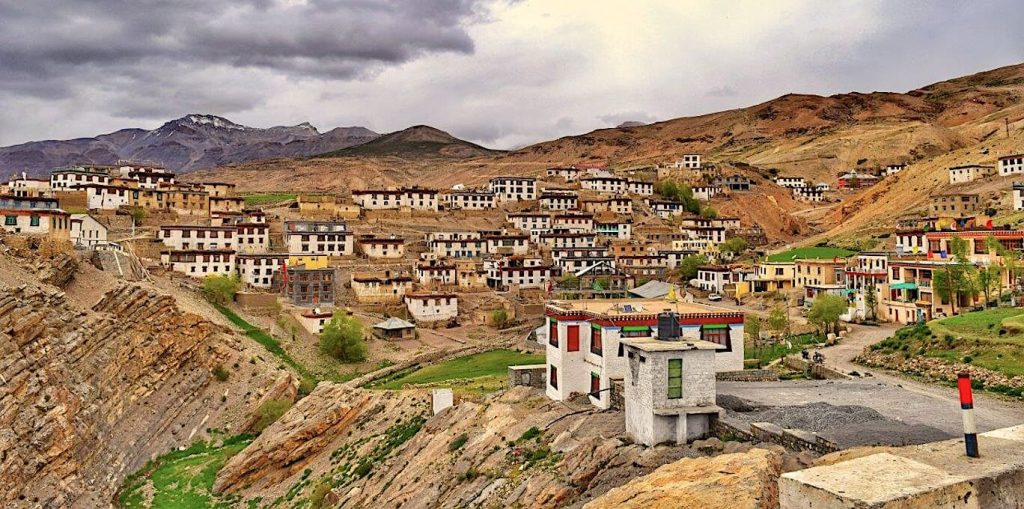
Overview of the Kibber, Spiti Valley
At an elevation of 4270 meters in Himachal Pradesh’s Spiti Valley, Kibber—also spelt Kyibar—is a little settlement. Kibber, which is surrounded by beautiful mountains and desolate scenery, takes pride in being the highest village with a motorable road. The Kibber Wildlife Sanctuary and the nearby monastery are two of the village’s most well-known attractions.
At the nearby rest stops, one can pass a day while the mountains keep watch. This community is distinguished by about 40 identical-looking Tibetan-style homes. Except for the traditional building materials like bricks, all of the dwellings are constructed of stone in symmetrical patterns. The raw materials are gathered from the nearby villages due to a lack of transportation resources. With 77 dwellings and only 366 residents, it is the village with the highest population. In the community, there are 179 women and 187 males.
In addition to these, a number of adjacent villages with a rich history and breathtaking scenery are worth seeing. Tibetan Buddhism is prevalent here, and the area has special meaning for Buddhists as it was where Serkong Rinpoche, the Dalai Lama’s tutor, passed away. In addition, he established Kibber Monastery. Despite being situated far away, it has a high school, hospitals, a post office, a telegraph office, and community television.
How To Reach Kibber
By car, one can go from Kaza to Kibber. Every day at five o’clock in the evening, a local bus departs from Kaza and travels the hour to Kibber. The same bus departs from Kaza and stops for the night. In the morning, it returns. Depending on demand, they might operate a second bus service in the morning during the busiest travel period.
You can get to Kibber by taking a shared taxi or calling a taxicab. Given that the peasants’ new source of money, they can demand exorbitant prices. To get the greatest deal, don’t forget to haggle.
Best Time To Visit Kibber
The greatest time to travel to Kibber, and by extension, Spiti Valley, is during the summer months of May to July. Despite being cold, the weather is pleasant. Trekking and sightseeing are best done now. Avoid visiting during the winter months when it gets below zero and highways can be closed for months.
Since the weather in this area is erratic, bring a lightweight jacket and an umbrella. We advise avoiding monsoon seasons because heavy rains frequently cause landslides and accidents. Additionally, because this is mountainous terrain, it is more challenging to drive on the roads when it rains.
Things you should Know before visiting Kibber
Location: Lahaul and Spiti District.
Distance from Spiti: 18.4 kms (40 minutes approximately)
Distance from Manali: 185.5 kms (4 hours 50 minutes approximately)
Mobile Connectivity: Poor.
Temperature: 11.5 °C (average temperature during summers), -9.5 °C (average temperature during winters)
10. Baralacha La
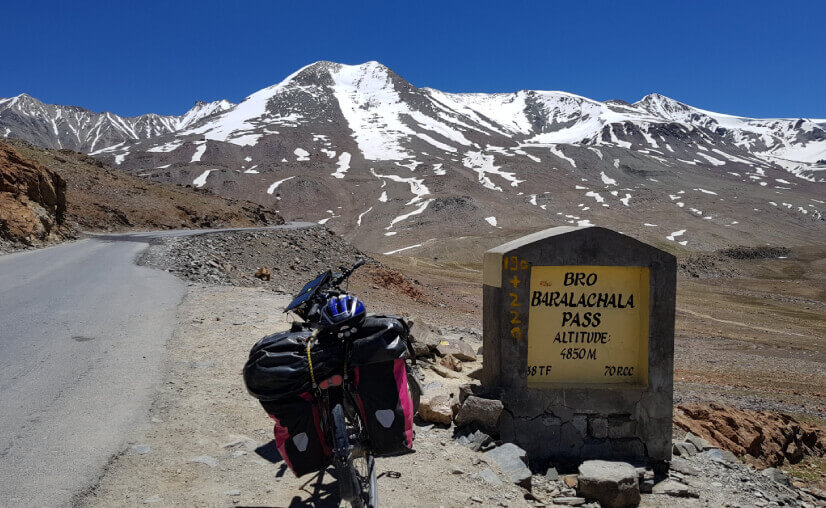
Overview of the Spiti Valley Baralacha La
The Baralacha La, often referred to as the Baralacha Pass, is a high mountain pass that is situated in the Zanskar range at a height of 16,040 feet above sea level. This 8-kilometer pass, which is situated along the Leh-Manali highway, links the Lahaul area in Himachal Pradesh with Ladakh in Jammu and Kashmir.
The Bhaga River, a branch of the Chenab River that rises from the Surya Taal Lake, is also located only a few km from this pass. Thus, there are many breathtaking landscapes all around the Baralacha Pass that captivate onlookers and leave them wanting more.
The renowned Baralacha Pass is also mentioned in Rudyard Kipling’s well-known book “Kim,” in which the Lama character travels from Tibet to India via the Suraj Tal. Visitors to this pass also adore the journey from the Baralacha to the Chandratal, which is located in the Spiti Valley on the banks of the Chandra River.
You can travel to a completely different universe by going to Baralacha La. Here, the environment and vistas are amazing, and the arid land devoid of any lodging facilities or retail establishments is beautiful.
Must Know Before You Visit Baralacha La
1. Exercise extra caution since the path is particularly hazardous due to the pass’s snowy cover, abrupt twists, and dismal weather.
2. Dress warmly, since the environment can get chilly due to the brisk winds that frequently blow in this area of high elevation.
3. Avoid cycling on the stretch after 5:30 or 6:00 p.m. if you intend to cycle in the evening. Think about stopping at adjacent locations.
4. Prepare for high altitude illness by acclimatising. Take enough medicine and water with you to battle it.
5. Food is only provided at the campgrounds because there are no restaurants at the pass. The majority of the food provided here is Tibetan cuisine, such as soup, noodles, and momos.
Baralacha La Weather and Best Time to Visit Baralacha La
Due to snow and heavy rain during the winter, the Baralacha Pass is blocked. The best months to visit the pass are from April to October, when the snow has melted and it is thought to be safe for passengers.
11. Spiti River
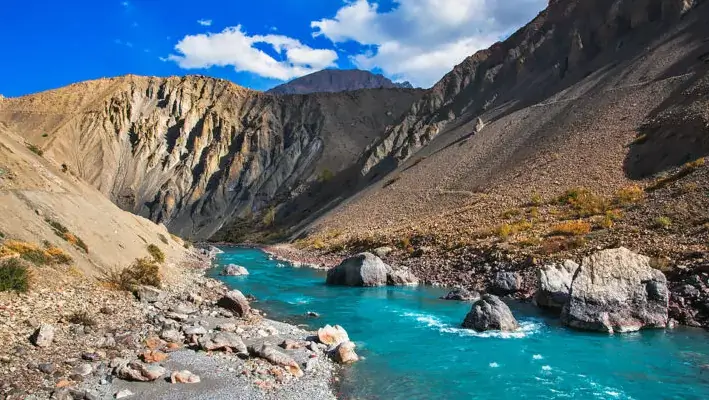
The Spiti River, which provides the Lahaul-Spiti district in the Himachal Pradesh state with its lifeblood, is a sight to behold. Many well-known Himalayan streams, like the Pin River, feed it from the Kunzum Range of the Himalayas, where it has its origin.
Since there are no rains in this region of the Himalayas, which appears to be like a desert environment, the river’s waters are supplied by the melting of glaciers.
The Spiti river is crucial to the majority of human habitation along its banks, generating towns like Tabo, Dhankar, Kaza, and Rangrik that have been around for more than a millennium. The section of the river between Kaza and Rangrik, which is visible from Key Monastery, is one of the most stunning.
Even though the river freezes over in the winter, some hotels in the Spiti Valley are known to arrange mud baths there when the conditions are right.
Location: Spiti River, Himachal Pradesh
Timings: N/A
Entry fee: N/A
12. Shashur Monastery
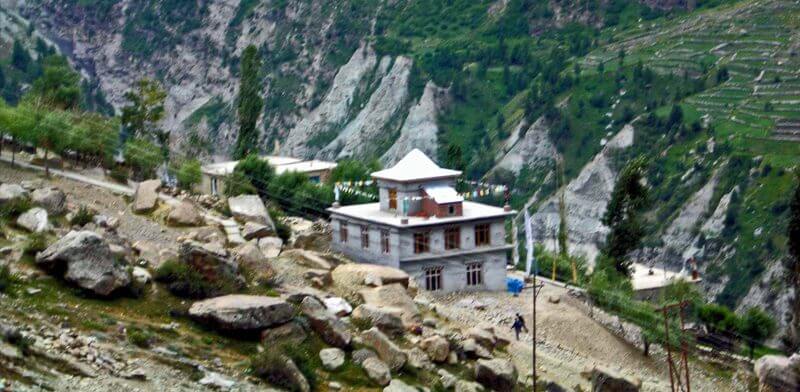
Monastery Shashur, Spiti Valley Overview
In the Himachal Pradesh state’s Lahaul Spiti district is the Buddhist monastery known as Shashur Monastery of the Drugpa Sect. It is a three-story building that may be found 35 to 40 kilometres from Manali. The Shashur Monastery is surrounded by blue pine trees, hence the word “Shashur” in the local tongue literally means “blue pines.”
Shashur Monastery offers a breathtaking panorama of the river, mountains, and Keylong town from its perch 600 meters above the valley. It was constructed in the 17th century using the Mandala design, which features a square with four gates and a circle in the middle.
Large Thangka paintings and wall paintings decorate the prayer chambers, adding to the attraction’s value. The stunning decor and architecture of Shashur Monastery have earned it accolades from all quarters. The annual Chham dance festival in July is the ideal time to go.
13. Trilokinath Temple
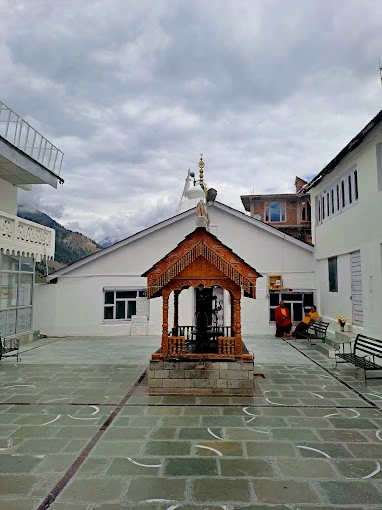
Overview of Trilokinath Temple in the Spiti Valley
The Trilokinath Temple, often referred to as Sri Trilokinathji Temple, is situated in Trilokinath village in the Himachal Pradesh state’s Lahaul and Spiti region. The temple is the only spot in the entire globe where both Hindus and Buddhists worship, and it is located about 9 km from the village of Udaipur (not to be confused with Udaipur in Rajasthan).
Buddhists refer to the deity as Arya Avalokiteshwar, while Hindus refer to it as “Lord Shiva.” Shiva, a Hindu deity, is also known as “Trilokinath,” which translates to “Lord of Three Worlds.” The Trilokinath Temple, on the other hand, is thought to have started out as a Buddhist monastery.
The stunningly white-painted temple in Trilokinath hamlet could be seen at the end of the roadway at a height of 2760 metres. The Trilokinath Temple was formerly known as “Tunda Vihar,” and along with Kailash and Mansarovar, it is regarded as the holiest pilgrimage site in the world.
Trilokinath Temple provides a tranquil scene and enchanted comfort to the eyes with its colourful Tibetan prayer flags waving in the breeze, the sound of the brass bell, and the surrounding snow-covered mountain peaks and pine trees. It is undoubtedly a wonderful location to explore for those who value tranquility and religion.
How to Reach Triloknath Temple
The entrance to the Lahaul and Spiti valley is at Rohtang Pass. From April to November, it is only accessible to tourists. The Trilokinath Temple is located 146 kilometers from Manali and 45 km from Keylong. Udaipur, the closest town, is just 9 kilometers away.
Large buses operated by the Himachal Pradesh Road Transport Corporation (HRTC) travel to Trilokinath from these surrounding towns. A different option is to hire a taxi in Manali, Kullu, or Udaipur.
14. Sapona Lake
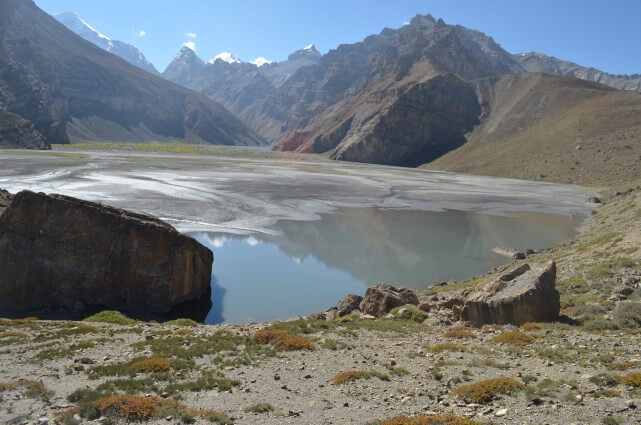
Overview
The Sopona Lake is a well-known attraction in Spiti for thrill-seekers. If you want to enjoy the ultimate experience, go to this lake that was created by melting glaciers. Some of the most beautiful vistas of the Spiti valley and the nearby Maniang Himalayan range may be found there.
Trekking to Manirang Pass, which is located in this area and has an elevation of 6593 metres, is one of the more well-liked tourist activities. The moderately challenging climb leads to some of Spiti Valley’s most breathtaking locations.
In 3 to 3.5 hours, one may complete the trek and take in the expansive vistas of the Dhangkar Valley. Being followed by a local village from Mane, who charge about 800 to 1000 rupees and provide you an amusing tour of the lake, is a terrific way to experience the walk.
Location: Sopona Lake, Himachal Pradesh
Timings:N/A
Entry fee: N/A
15. Sakya Tangyud Monastery
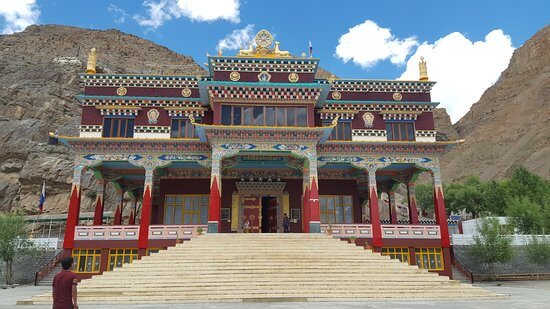
Sakya Tangyud Monastery, one of Spiti’s well-known attractions, is a visual pleasure. It is located at a height of 4520 meters in the Komic hamlet of the Spiti Valley. One of the highest altitude gompas in India, it serves as a place for Buddhist education and is surrounded by stunning scenery.
The monastery provides some of the most breathtaking views of the valley and is situated on the boundaries of the Kibber Wildlife Sanctuary. The monastery, which is one of the must-see locations in the Spiti Valley, includes fortified structures embellished with red ochre and mud walls. There are only two monasteries in the Spiti Valley that are associated with the Sakya sect, and this is one of them.
Location: Kaza, Himachal Pradesh 172114
Timings: 6 am to 6 pm
Entry fee: No entry fees
16. Kungri Monastery
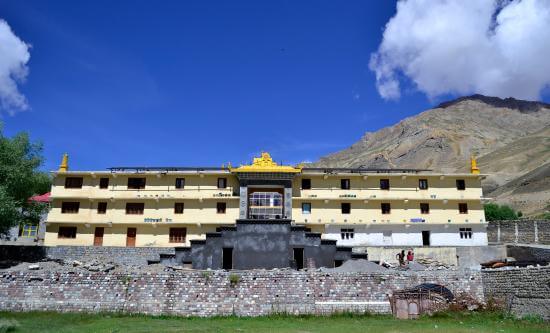
Overview
One of the top locations to visit in Spiti is Kungri Monastery, which is renowned for being the second-oldest Gompa in the Lahaul and Spiti Valley. The Nyingmapa order of Buddhism, which is considered to be the earliest branch of Tibetan Buddhism, is the one that runs the monastery.
The monastery, which is situated in Pin Valley, was established in the 14th century and is famed for its collection of silk paintings depicting various Buddhist deities. It also has other distinctive elements, such as large statues that represent the ancient Tantric religion and sacred Tibetan writings.</p>
The annual performance of the “Devil Dance,” which takes place in the month of July every year, and the sword dance, a significant highlight of Nyingmapa history, are two of Kungri Monastery’s main draws. A haven for culture enthusiasts, Kungri Monastery is frequented by throngs of tourists, pilgrims, and individuals interested in learning more about Buddhism.
Location: Kungri, Himachal Pradesh 172114
Timings: 6 am to 5:30 pm
Entry fee: N/A Lo
17. Langza village
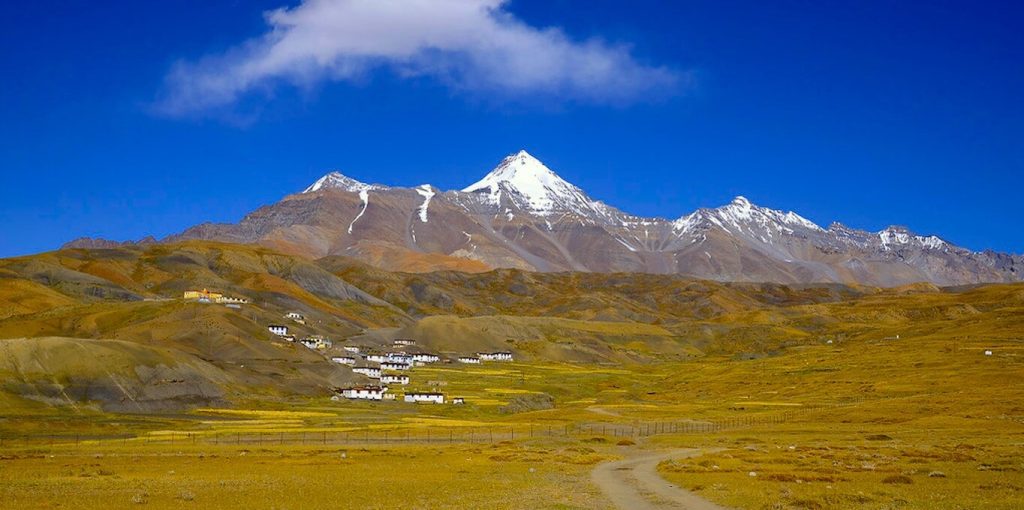
Tashigang is a small, picturesque settlement at a height of 4650 meters with a total of 6 families and a population of approximately 40. One of the most remote yet fascinating spots to visit in Spiti, the village’s entrance is littered with old chortens.
When you visit the village, it’s like going back in time to see the thatched roof buildings, the tiny lake, and the farmers at work. The picture-perfect village is a haven for loners who keep looking for locations without a mobile network.
The picturesque settlement, which is close to the border between India and China, is plagued by chilly winds and a lot of snow. Despite all the challenges they encounter while being here, Tashigang Village serves as the six families’ only haven.
Location: Tashigang Village, Himachal Pradesh
Timings: N/A
Entry fee: N/A
18. Hikkim, World’s Highest Post Office
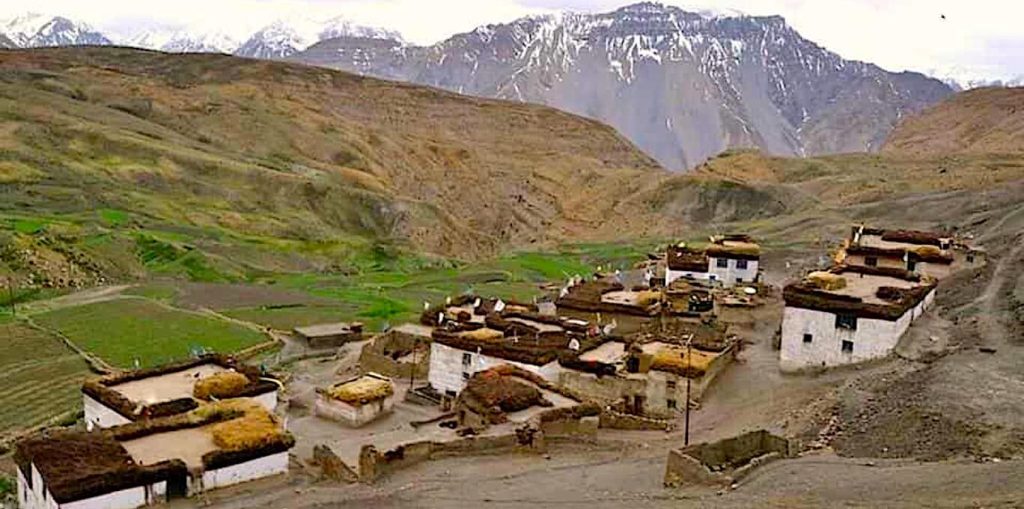
Overview
The World’s Highest Post Office in the village of Hikkim is a delight to see for anyone looking for unique locations to see in Spiti. Even though snowfall frequently hinders the work of the post office, Postmaster RinchenChhering is a symbol of tenacity in this little community because he occasionally resorts to carrying mail by foot.
To transport mail to Kaza, postmen must travel 46 kilometres (km) each day across mountain passes and lush meadows. The opportunity to send letters to loved ones from the highest post office on Earth makes it a special experience for tourists.
At a height of 4440 metres, this post office is connected to the other Himachal Pradesh towns by roadways. Additionally, the area has one of the most beautiful postal routes, which passes through the spellbinding Spiti Valley and peaks covered with snow.
Location: Hikkim, Himachal Pradesh
Timings: 6 AM to 5 PM Monday through Friday
Entry fee: N/A
19. Kaza
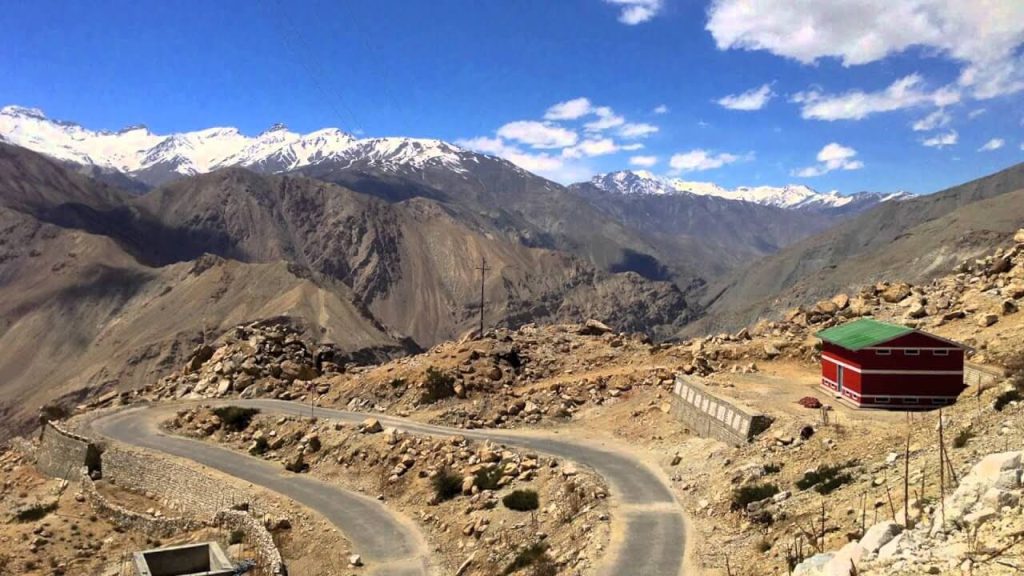
Overview
Kaza is a calm and tranquil location in the Spiti Valley, tucked away in a corner of the lovely Indian state of Himachal Pradesh. This idyllic location is nothing less than a heaven on earth, filled with towering mountains covered with snow, roaring rivers, breathtaking scenery, and glistening streams.
Kaza’s entire town can be divided into New Kaza and Old Kaza. Government offices are located in the latter, and the former houses the king’s palace. This picturesque town has a certain mystique to it because of the historical treasures, monasteries, and gompas that are there. The Himalayan town of Kaza now boasts a unique fusion of ancient culture and modernity that is likely to completely astound and spellbind every traveler.
Tourists who want to engage in both spiritual and adventurous activities are drawn to Kaza by its natural landscapes and steep topography. Even so, it serves as a base camp from which tourists can set out to engage in sports like trekking and mountaineering. Pin-Bhaba, Parang-La, and Pin-Parvati are a few well-known paths that leave from the town of Kaza. Visitors to this area like taking walks to the small villages close to Kaza town, which provides an interesting and distinctive experience, in addition to participating in adventure sports and visiting various Buddhist shrines.
From the Kinnaur Valley and Lahaul Valley, one can reach Kaza. The earlier route only opens during the summer season, whilst the later route is open all year. This destination’s winter season is marked by exceptionally low temperatures, which make the town’s climate exceedingly chilly. The residents prefer to stay indoors at this time and only leave the house if it is absolutely necessary. They always have enough food on hand for this time of year, and they spend the entire time indoors crafting.
The town of Kaza is provided with a wealth of respectable lodging options and dining establishments, assisting visitors in having a relaxing trip. Together, these factors enable tourism to thrive in this small Himalayan town.
How To Reach Kaza
Via Road – Roadways conveniently link the town of Kaza to all the significant geographic regions of the nation. Government buses are frequently available to and from Kaza. There are two buses that travel daily from Shimla to Kaza, one leaving at dawn and the other at dusk. There are also two HRTC buses that run daily between Manali and Kaza, both of which typically depart early in the morning.
By Air – Unfortunately, there are no flights that go directly to the city. The airport in Bhuntar, which is about 250 kilometres away from the town of Kaza, is the one that is closest to it. You can take a bus to get to Kaza once you’ve landed at this airport.
By Rail – There are no direct trains from other regions of the nation to Kaza. 365 kilometres away, in Joginder Nagar, is the closest railway station to the town. You can board a bus to Kaza after arriving here.
Best Time To Visit Kaza
The months of June to October are ideal for traveling to the Himalayan town of Kaza. During this period, travelers can easily reach Kaza using the routes from Manali and Shimla. The Kunzum Pass is also accessible during these months.
The frigid desert of Kaza is likewise more popular with tourists from November to February. Travelers can access the town during this season by using the Shimla route, which is available all year long.
Conclusion
Spiti Valley is a treasure trove of natural and cultural wonders, and visiting these places will give you a glimpse into the region’s rich heritage and stunning landscapes.
Exploring Spiti Valley also offers opportunities for adventurous activities like trekking, mountain biking, and wildlife spotting. The rugged terrain and remote locations provide a unique experience for those seeking off-the-beaten-path adventures. Additionally, interacting with the local communities and experiencing their traditional way of life adds a cultural dimension to any visit to Spiti Valley.
Here you can check our Spiti Valley Package
People Also Ask About Best Places To Visit In Spiti Valley
What is Spiti Valley?
Spiti Valley is a remote and high-altitude region located in the Indian state of Himachal Pradesh. It is known for its breathtaking landscapes, rugged terrain, and unique Tibetan culture.
When is the best time to visit Spiti Valley?
The best time to visit Spiti Valley is during the summer months from June to September when the weather is relatively pleasant and the roads are open. However, some parts of Spiti may be accessible even in winter for adventure enthusiasts.
How do I reach Spiti Valley?
You can reach Spiti Valley by road from Manali or Shimla. The nearest airport is in Kullu, and you can also take a bus from major cities in Himachal Pradesh.
Is a permit required to visit Spiti Valley?
Yes, Indian tourists need an Inner Line Permit (ILP) to visit Spiti Valley, which can be obtained in Shimla or Reckong Peo. Foreign nationals require a Protected Area Permit (PAP) for the same.
What are the accommodation options in Spiti Valley?
Accommodation options in Spiti Valley include guesthouses, homestays, and basic hotels. Camping is also a popular choice, especially in remote areas.
What should I pack for a Spiti Valley tour?
Pack warm clothing, as temperatures can drop significantly, even in summer. Also, carry essentials like a first-aid kit, a refillable water bottle, and any specific medications you might need.
Is there a mobile network in Spiti Valley?
Mobile network coverage is limited and unreliable in many parts of Spiti Valley. BSNL and some private operators may work in larger towns, but it’s best to be prepared for limited connectivity.
What are the must-visit places in Spiti Valley?
Some of the must-visit places in Spiti Valley include Key Monastery, Kaza, Chandratal Lake, Dhankar Monastery, and the Pin Valley National Park.
Is it safe to travel to Spiti Valley?
Spiti Valley is generally safe for tourists, but you should be prepared for high-altitude conditions, challenging roads, and limited amenities. Follow local guidelines and travel with a reliable vehicle and an experienced driver.
Can I find vegetarian food in Spiti Valley?
Yes, you can find vegetarian food options in Spiti Valley, but the choices might be limited in remote areas. The local cuisine is influenced by Tibetan culture and includes dishes like thukpa and momos.
What activities can I enjoy in Spiti Valley?
You can indulge in trekking, monastic visits, wildlife photography, stargazing, and experiencing the unique culture of the region.
Are there any medical facilities in Spiti Valley?
There are basic medical facilities in larger towns like Kaza. However, it’s advisable to carry essential medications and a well-stocked first-aid kit when traveling to remote areas.
What is the weather like in Spiti Valley?
The weather in Spiti Valley is cold, even in summer. Winters are extremely harsh, and roads are often closed due to heavy snowfall. Summers are relatively mild, but nights can be cold.
Remember that Spiti Valley is a remote and high-altitude destination, so it’s important to plan your trip carefully and be prepared for challenging conditions.
